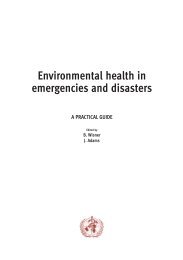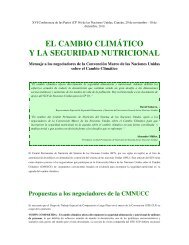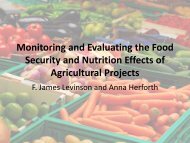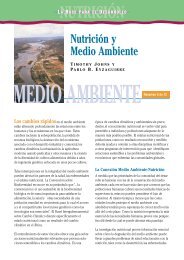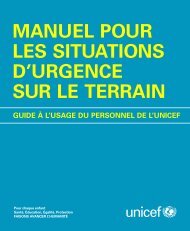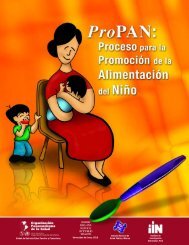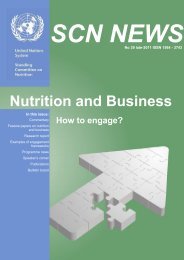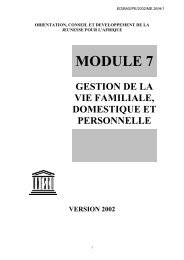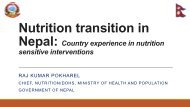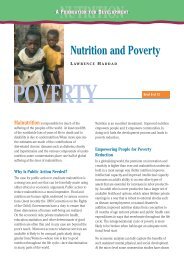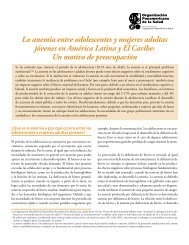SCN News No 36 - UNSCN
SCN News No 36 - UNSCN
SCN News No 36 - UNSCN
You also want an ePaper? Increase the reach of your titles
YUMPU automatically turns print PDFs into web optimized ePapers that Google loves.
www.unsystem.org/scn<br />
ELECTRONIC SUPPLEMENT<br />
S1<br />
Update on REACH – Ending Child Hunger and Undernutrition<br />
Denise Costa Coitinho on behalf of the Inter-Agency Team hosted by WFP<br />
Nutrition is a desperately neglected aspect of maternal, newborn, and child health. The medical journal The<br />
Lancet in its new maternal and child undernutrition series (Maternal and Child Undernutrition Study Group<br />
2008), finds that 90% of the world’s undernourished children live in just <strong>36</strong> countries, and intensified nutrition<br />
action in these countries would greatly contribute to the achievement of the first Millennium Development<br />
Goal (MDG1) and substantially increase the chances of achieving goals for reducing child and maternal mortality<br />
and disease (MDGs 4, 5 and 6). UNICEF (2007) found that 51 developing countries are making<br />
insufficient progress towards MDG1’s ‘hunger target’, as measured by the prevalence of underweight among<br />
under-fives. Eighteen of these were making no progress at all or were going backwards.<br />
To accelerate countries’ progress on MDG-1, Target 2 (halve the proportion of underweight under-fives), the<br />
global community has realised that there is an urgent need for renewed efforts against child hunger, as a priority<br />
in the identified <strong>36</strong> countries. Such a renewed effort requires government-led, solution-focused partnerships<br />
among the UN, civil society and private sectors. What is also needed is a redirection of funds and attention<br />
to support the delivery of proven nutrition interventions at scale. There is a need for seamless nutrition<br />
support between children under five and those of school age. A coherent joint response from the UN and<br />
partners in support of national governments is urgently required to move these efforts forward. To fulfil this<br />
perceived need, WFP, UNICEF and partners, have been developing the Ending Child Hunger and Undernutrition<br />
Initiative (ECHUI) since 2006.<br />
ECHUI was first presented to the <strong>SCN</strong> during its 34 th session, in Rome. The <strong>SCN</strong> welcomed ECHUI, endorsed<br />
its goals, and recommended that it be a broad-based partnership with close links to the <strong>SCN</strong>. A series<br />
of concrete recommendations were made with various offers of technical or managerial support to further<br />
strengthen ECHUI:<br />
1. The <strong>SCN</strong> should provide an advisory role to ECHUI;<br />
2. ECHUI should build on existing <strong>SCN</strong> structures (Working Groups and Task Forces);<br />
3. The <strong>SCN</strong> and ECHUI Secretariats should be closely articulated; and,<br />
4. ECHUI should report on progress at the <strong>SCN</strong> Annual Sessions.<br />
The progress report to the 35th session of the <strong>SCN</strong> aimed at meeting the fourth recommendation.<br />
In July 2007, ECHUI was approved by WFP and UNICEF Executive Boards. The two organizations were<br />
requested to continue developing ECHUI including further refining of the workplan, developing the Partners<br />
Group, and preparing the ground for the Secretariat. In the same month, ECHUI preliminary studies in<br />
Mauritania and Niger were concluded and by the end of 2007 the WHO-led Landscape Analysis on<br />
Countries' Readiness to Accelerate Action in Nutrition was initiated (WHO 2008). In <strong>No</strong>vember 2007, the<br />
WHO Director-General Dr Margaret Chan joined the effort and seconded a staff member to Rome. The Inter-<br />
Agency Team was then established in Rome, hosted by WFP. Following these good developments, the FAO<br />
Director-General Dr Jacques Diouf joined the effort as the fourth core partner, in January 2008.<br />
In February 2008, the Lancet series on maternal and child undernutrition was launched and ECHUI-promoted<br />
interventions accordingly revised and organized into “big five” priority action areas, to achieve four agreed<br />
outcomes:<br />
1. increased awareness and understanding of the problem of hunger and undernutrition, and of known<br />
solutions;<br />
2. supported national policy and programme development;<br />
3. increased capacity for action at all levels; and,<br />
4. increased monitoring, efficiency and accountability of global efforts<br />
More focus and a roll-out plan that brings together on-going initiatives was then proposed by the Inter-Agency<br />
Team. The new brand ‘REACH: ending child hunger and undernutrition’ was also proposed. Progress to date<br />
is presented now to the <strong>SCN</strong> for further advise.<br />
back to contents <strong>SCN</strong> NEWS # <strong>36</strong>




